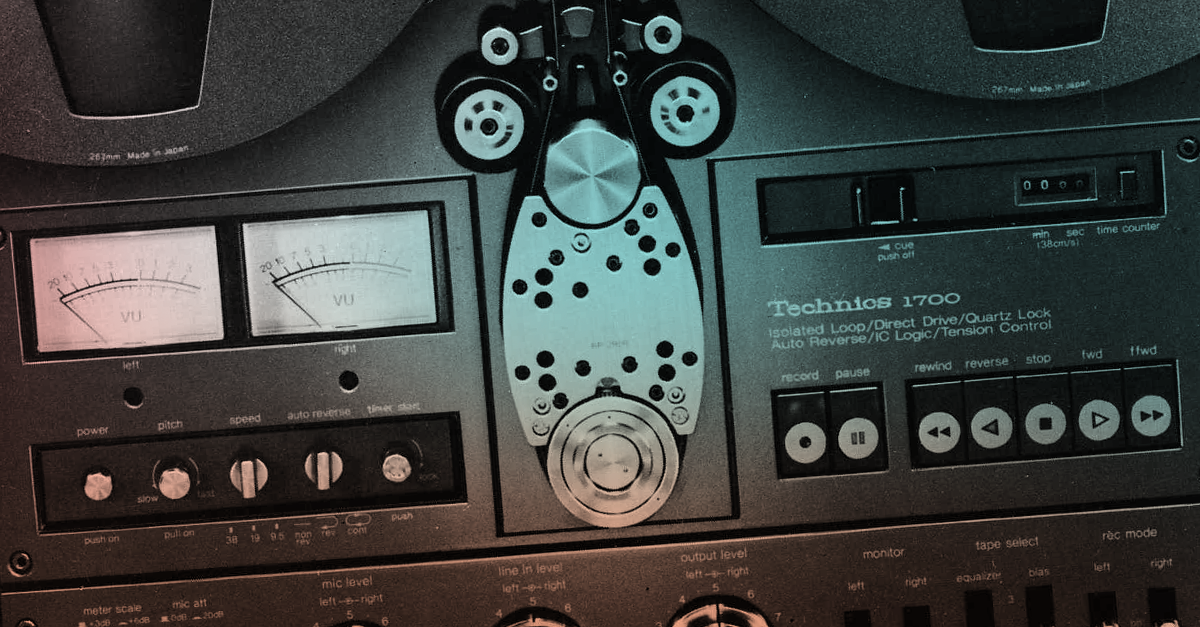5 Moments in the History of Tape That Shaped Modern Music
Before the synthesizer, electronic experimenters were already at work with another instrument—the tape recorder.
Before the ability to record, musical excellence, virtuosity and authenticity were associated with playing a live instrument. In fact, recording was often perceived as a ‘dishonest’ activity by some artists at its introduction. Until it fell into the hands of those willing to experiment…
Of course magnetic tape isn’t the first recording medium—we had paper or wax cylinders and vinyls discs before. But magnetic tape had an excellent frequency response, it was cheap, and you could easily cut and splice it. In other words it was a tweaker’s paradise.
The ability to record and especially manipulate sounds was a completely new concept that tape unlocked. You could take music out of its time and place, hear it again, cut it up and rework it into something else. The tape recorder was turned on its head and became an instrument.
In the big picture of music it was the beginning of a whole new era of creativity—we’re still feeling the effects right now.
Here are 5 key moments in the history of tape music that changed the way we make music today.
1. The First Electronic Music Composition
“The cradle of electronica is Cairo” wrote Rob Young in The Wire.
Many have crowned Pierre Schaeffer as the originator of electronic music. But the world’s first electronic composition is actually “Ta’abir Al-Zaar” made in 1944 by the Egyptian experimenter Halim El-Dabh.
El-Dabh used a wire recorder to capture zaar, a women’s healing ceremony featuring drums, flutes and singing. He returned to the Middle East Radio station and used echo and reverb chambers to manipulate the timbres. He isolated, enhanced and removed certain frequencies.
He then transferred his composition onto a reel-to-reel, edited the composition, and renamed it “Ta’abir Al-Zaar” — The Expression of Zaar. The original piece was not preserved but a 2 minute excerpt appeared on CD under the title ‘Wire Recorder Piece.’
What was so striking about this concert? It showcased the creative capabilities of tape in conjunction with classical instruments — distortions, superimpositions, echoes and timbral transformations fused with an orchestral composition.
The result was an eerie and completely new kind of sound for the time. It marked the beginning of an American chapter in the legacy of tape music already happening in France, Britain and other parts of the world.
“Just as the painter paints [their] picture directly with colors, so the musician composes [their] music directly with tone…” Leopold Stokowski
The famous conductor Leopold Stokowski — who went to the show — described tape music as:
“Music that is composed directly with sound instead of first being written on paper and later made to sound. Just as the painter paints [their] picture directly with colors, so the musician composes [their] music directly with tone…”
In the late 1950s, Ussachevsky and Luening founded the seminal Columbia-Princeton Electronic Music Center.
3. Pierre Schaeffer and Musique Concrète
Founded in 1951, the Groupe de Recherches Musciales (GRM) was a studio based out of the Radiodiffusion-Télévision Française (RTF) headquarters in Paris. The GRM is the historic electro-acoustic music group founded by composers Pierre Schaeffer and Pierre Henry, and engineer Jacques Poullin.
Musique concrète was among the first movements to add recorded and electronic sounds into the composer’s toolset.
This studio allowed Pierre Schaeffer to continue developing his theory of musique concrète: a music that used recorded sounds as base material for composing. Shaeffer encouraged acousmatic listening—listening to sounds for their acoustic and rhythmic qualities without knowing or trying to know what causes them. Tape played a fundamental role as a medium for recording and manipulating those experiments.
The techniques developed by Shaeffer for editing sounds laid the foundations for the sampling and computer music approach we all use today, specifically altering the pitch, reversing a recording, cutting, filtering to name a few….
“This century, the technology has caught up with Delia. We can now do digitally what Delia was doing in analog terms. Delia would be having a bore now” asserts Mark Ayres in The Delian Mode documentary.
We Owe It to Tape
The style of music coming out of the BBC Radiophonic workshop, the Tape Music Center, the GRM and others of that period created an aesthetic and technical legacy that inspired generations of upcoming artists. It laid the foundation for how we all create music today.
The well-known German composer Karlheinz Stockhausen commented on the importance of tape:
“This is the most important: for the first time in history we have the possibility to make the sound become fixed for a while and work on it. Traditionally, sound was constantly moving. Once it was produced, it was gone.”
Tape is the the technology that gave us recording, sampling, looping, delay… So the next time tape seems obsolete in the days of digital, don’t forget that its histories loop back into modern music everyday.
Gear guides, tips, tutorials, inspiration and more—delivered weekly.
Keep up with the LANDR Blog.
